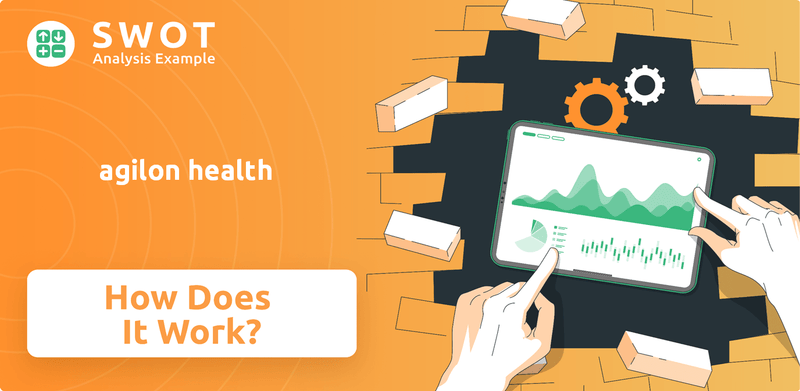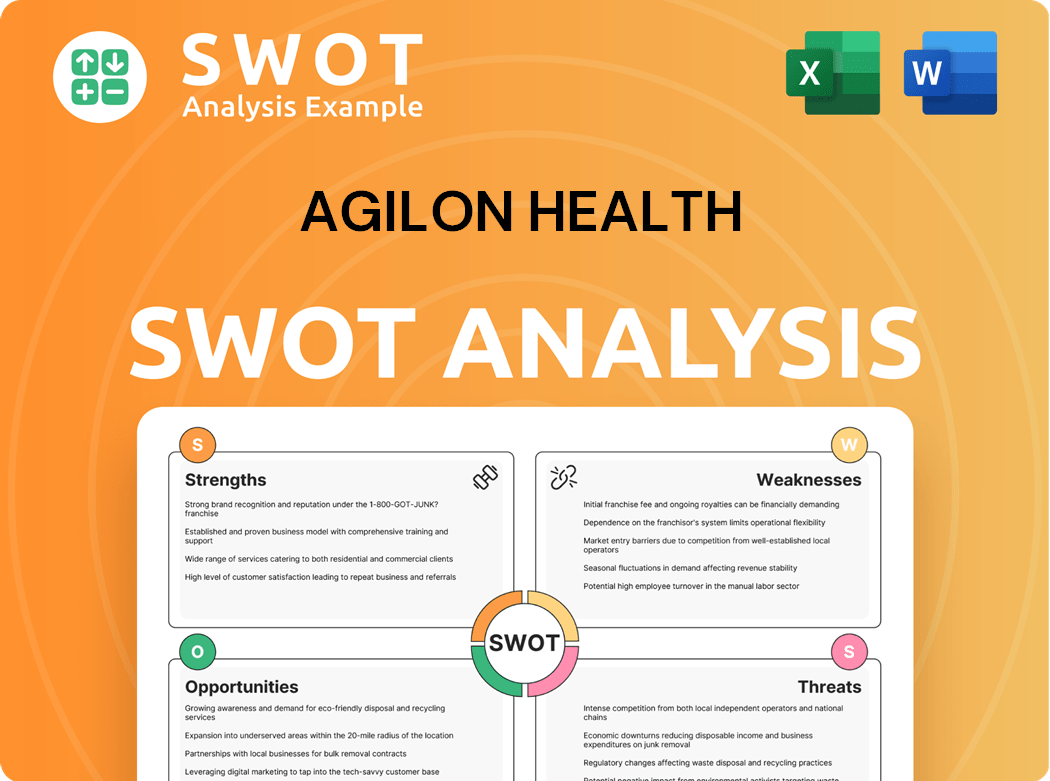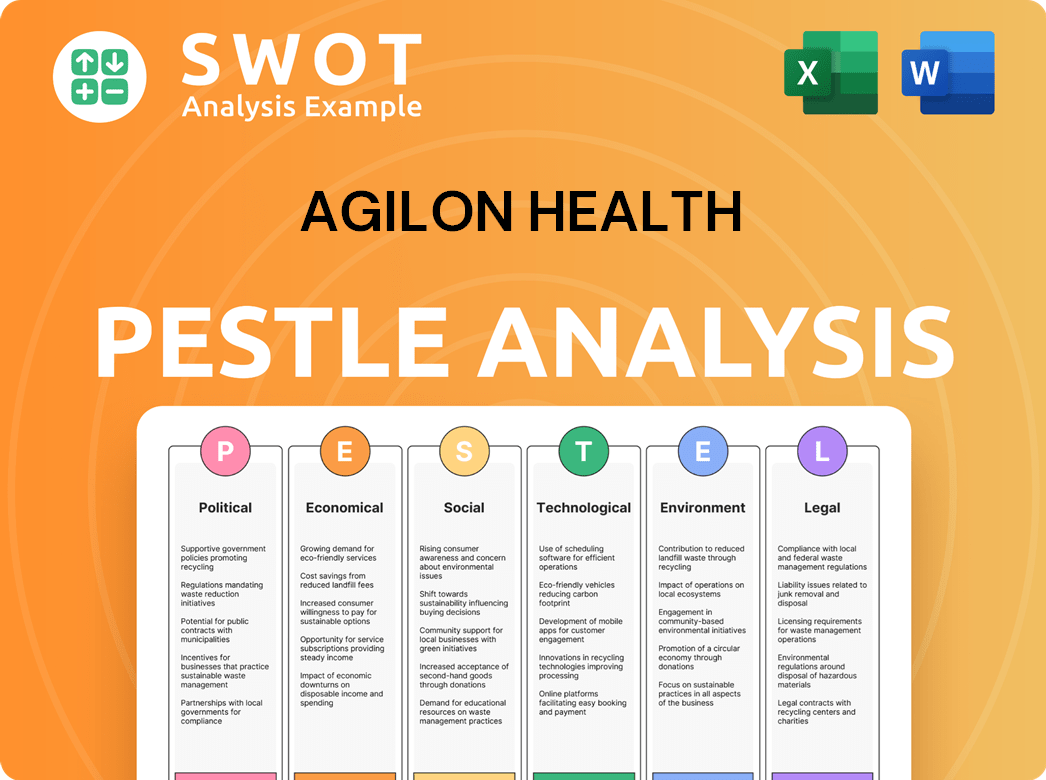agilon health Bundle
How Does Agilon Health Thrive in the Healthcare Revolution?
Witness the remarkable ascent of agilon health, a healthcare innovator reshaping how primary care is delivered to seniors. With a staggering 44% revenue surge in Q4 2024, reaching $1.52 billion, and a 40% annual revenue increase to $6.06 billion, agilon health is rapidly expanding its influence. This growth, fueled by a 36% rise in Medicare Advantage membership, highlights the company's powerful impact on the healthcare landscape.

Agilon Health empowers community-based physician groups to embrace a full-risk, agilon health SWOT Analysis value-based care model, prioritizing patient outcomes and cost reduction. This innovative approach, a cornerstone of the agilon health business model, is crucial for healthcare providers navigating the evolving market. Understanding agilon health's operational strategies and financial performance, including how it generates revenue, is vital for anyone invested in the future of population health and the success of independent physicians.
What Are the Key Operations Driving agilon health’s Success?
The core of agilon health's operations centers on its 'Total Care Model.' This model helps primary care physicians (PCPs) transition to value-based care, mainly for their senior patients in the Medicare Advantage (MA) sector. The company offers a comprehensive technology and services platform. This platform supports physician groups in managing patient health, improving outcomes, and lowering the overall cost of care.
This model prioritizes the quality of care over the volume of services. This approach aligns incentives for better patient health and financial sustainability. The company's main goal is to enable PCPs to succeed in value-based care arrangements. This is achieved through a combination of technology, data analytics, and operational support.
The company provides a platform that includes technology, data capabilities, human resources, and insights. This helps physician partners manage risk-sharing agreements effectively. As of March 31, 2025, the platform served a total of 605,000 members. This includes 491,000 Medicare Advantage members and 114,000 ACO REACH beneficiaries. In 2024, the network reinvested over $250 million into local primary care.
The company provides a platform offering technology, data capabilities, and human resources. This helps physician partners manage risk-sharing agreements. Operational processes involve supporting physician onboarding, enhancing quality performance, and managing clinical expenses. The company's partnerships are typically long-term, fostering strong relationships.
The company's model integrates palliative care into primary care. This leads to improved patient outcomes, such as a two-thirds lower likelihood of hospital death for certain patients. The robust network and proven model of improving patient outcomes and reducing costs translate into significant customer benefits. This also creates market differentiation.
The value proposition of the company lies in its ability to empower community-based physicians. It allows them to maintain their independence while transforming care delivery. The company's strong physician partnerships, which included over 3,000 primary care physicians in 30+ communities as of May 2024, are vital.
- Focus on value-based care.
- Support for independent physicians.
- Improved patient outcomes.
- Financial sustainability for physicians.
agilon health SWOT Analysis
- Complete SWOT Breakdown
- Fully Customizable
- Editable in Excel & Word
- Professional Formatting
- Investor-Ready Format

How Does agilon health Make Money?
The revenue streams and monetization strategies of agilon health are primarily centered around its partnerships with physician groups and their transition to value-based care arrangements. This approach is a key element of the agilon health business model, focusing on managing the health of senior patients, especially those enrolled in Medicare Advantage and ACO models. The company's financial health is closely tied to its ability to manage medical costs effectively while expanding its membership base.
agilon health's financial performance is driven by its 'Total Care Model,' which emphasizes value-based care. This model allows the company to generate revenue through various means, including capitation payments and shared savings from improved patient outcomes. The company's ability to grow its revenue and maintain profitability depends on its success in managing healthcare costs and expanding its network of healthcare providers.
For the fiscal year 2024, agilon health's total revenue increased by 40% to $6.06 billion, up from $4.32 billion in 2023. In the first quarter of 2025, total revenues were $1.53 billion. This growth is largely due to membership expansion in new markets and organic growth within existing geographies. The company's financial results and strategies are crucial for understanding its position in the Competitors Landscape of agilon health.
agilon health's monetization strategy is built around its 'Total Care Model' and value-based care arrangements. The company focuses on managing the health of senior patients, primarily through Medicare Advantage and ACO model beneficiaries. Key aspects of this strategy include:
- Medical Margin: A critical metric, representing the difference between revenue and medical costs. In Q4 2024, the medical margin was $1 million, compared to a negative $102 million in Q4 2023. For the full fiscal year 2024, the Medical Margin was $205 million, a decrease from $299 million in 2023. In Q1 2025, the medical margin was $128 million, down from $157 million in Q1 2024.
- Medicare Part D Risk Mitigation: Reducing exposure to Medicare Part D risk, with less than 30% of its membership carrying Part D risk in 2025, significantly down from approximately 70% in 2024.
- Glide Path Approach: Implementing a phased approach for new partnerships, starting with care management fees and transitioning to full risk.
- Quality Incentives: Securing incremental quality incentives, with $25 million in incremental quality incentives for 2025.
- ACO Model Contribution: Anticipating adjusted EBITDA contribution from its ACO model to be approximately $35-$40 million for fiscal year 2025.
agilon health PESTLE Analysis
- Covers All 6 PESTLE Categories
- No Research Needed – Save Hours of Work
- Built by Experts, Trusted by Consultants
- Instant Download, Ready to Use
- 100% Editable, Fully Customizable

Which Strategic Decisions Have Shaped agilon health’s Business Model?
Navigating the dynamic healthcare sector, agilon health has strategically evolved, marked by key milestones and significant partnerships. The company's approach to value-based care and its focus on healthcare providers have shaped its trajectory. Recent moves, including new partnerships and adjustments to its business model, highlight its commitment to sustainable growth and operational efficiency.
The company's strategic actions have been geared towards adapting to market challenges and optimizing its financial performance. This includes refining its network and focusing on profitable growth. These moves reflect a proactive approach to managing risk and ensuring long-term viability within the competitive landscape of population health.
In May 2024, agilon health announced new long-term partnerships with five physician practices, including Graves Gilbert Clinic, Mankato Clinic, Springfield Clinic, and Twin Cities Network. This expanded its network to over 3,000 primary care physicians serving more than 700,000 senior patients across 30+ communities. This also marked the company's entry into the state of Illinois.
The company has expanded its Physician Network, establishing new partnerships. This growth has been a central part of its strategy. In 2024, the company entered the state of Illinois.
To address profitability challenges, the company has implemented strategic actions, including exiting select partnerships. By the end of 2024, it planned to exit two unprofitable partnerships and certain payor contracts. The company is slowing growth intentionally in 2025 to prioritize profitability.
The company's competitive advantages include strong physician partnerships and a growing network of primary care physicians. Its proprietary technology platform supports data analytics and care coordination. This model has a track record of improving patient outcomes and reducing costs.
The company is enhancing its financial data capabilities through a new financial data pipeline to improve revenue and claims information management. The company is adapting by slowing growth intentionally in 2025, with a smaller class of approximately 20,000 new Medicare Advantage members, compared to over 100,000 previously, to prioritize profitability.
Agilon health faced operational challenges, including elevated medical cost trends, which were 6.8% in 2024 and are projected to be 6.3% gross and 5.3% net for 2025 for year 2+ markets. To address profitability challenges and reduce underwriting risks, the company implemented strategic actions, including the exit of select partnerships and contracts. By the end of 2024, the company planned to exit two unprofitable partnerships and certain payor contracts, which were expected to reduce membership by 45,000 to 75,000 members and annualized revenue by approximately $470 million to $785 million. These exits reflect a strategic focus on balanced growth and margin maturation.
- The company is focused on balanced growth and margin maturation.
- The company is enhancing its financial data capabilities.
- The company is slowing growth intentionally in 2025.
- The company's model has a track record of improving patient outcomes and reducing costs.
For more insights, you can explore the Growth Strategy of agilon health.
agilon health Business Model Canvas
- Complete 9-Block Business Model Canvas
- Effortlessly Communicate Your Business Strategy
- Investor-Ready BMC Format
- 100% Editable and Customizable
- Clear and Structured Layout

How Is agilon health Positioning Itself for Continued Success?
The company holds a prominent position in the value-based care sector, especially within Medicare Advantage. Through its model, it collaborates with over 2,200 primary care physicians across 30 communities in 12 states, serving approximately 615,000 senior patients. This focus aligns with the growing trend in U.S. healthcare, where value-based care represented roughly 60% of payments in 2024. Agilon's success in reducing ER and inpatient utilization and achieving high Medicare Advantage quality scores underscores its effectiveness and contributes to customer loyalty.
Despite its strong market position, Agilon faces several key risks. The healthcare sector, particularly Medicare Advantage, is experiencing significant challenges, including persistent medical cost pressures. Elevated utilization, especially in inpatient services and Part B drugs, also contributes to these trends. Uncertainties related to Part D and Group Medicare Advantage risk pose additional challenges. The company reported a net loss of $260 million for the fiscal year 2024, indicating ongoing profitability pressures.
Agilon Health is a key player in the value-based care market, particularly within Medicare Advantage. The company's model focuses on partnering with primary care physicians to improve patient outcomes and manage costs. The company's success is evident in reduced hospital utilization rates and high Medicare Advantage quality scores.
The company faces significant risks, including medical cost pressures and uncertainties related to Part D and Group Medicare Advantage. Elevated inpatient service utilization and Part B drug costs also pose challenges. Agilon reported a net loss of $260 million for the fiscal year 2024, highlighting financial pressures.
Agilon Health is focused on sustaining and expanding its revenue generation capabilities. The company aims to reach cash flow breakeven by 2027. Strategic initiatives include reducing Part D exposure and implementing a measured growth strategy.
Agilon Health is projecting total revenues between $5.85 billion and $6.025 billion for 2025. The company has reported a net income of $12 million in Q1 2025, compared to a net loss in Q1 2024, indicating improving profitability. The company is optimistic about a more favorable overall environment in 2026 and beyond.
Agilon Health is implementing several strategies to navigate the current market conditions and achieve its financial goals. These include reducing its Part D exposure and focusing on a more measured growth approach for 2025. The company aims to reach cash flow breakeven by 2027, reflecting a revised timeline based on the current market environment.
- Reduce Part D exposure to less than 30% of membership for 2025.
- Implement a measured growth strategy for 2025, with approximately 3% same-geography growth.
- Target cash flow breakeven by 2027.
- Agilon Health's model focuses on partnering with primary care physicians to improve patient outcomes and manage costs.
The company's focus on value-based care, as highlighted in this analysis of the Target Market of agilon health, positions it well in a growing segment of the healthcare industry. Despite the risks, the company's strategic initiatives and financial goals indicate a commitment to long-term growth and sustainability.
agilon health Porter's Five Forces Analysis
- Covers All 5 Competitive Forces in Detail
- Structured for Consultants, Students, and Founders
- 100% Editable in Microsoft Word & Excel
- Instant Digital Download – Use Immediately
- Compatible with Mac & PC – Fully Unlocked

Related Blogs
- What are Mission Vision & Core Values of agilon health Company?
- What is Competitive Landscape of agilon health Company?
- What is Growth Strategy and Future Prospects of agilon health Company?
- What is Sales and Marketing Strategy of agilon health Company?
- What is Brief History of agilon health Company?
- Who Owns agilon health Company?
- What is Customer Demographics and Target Market of agilon health Company?
Disclaimer
All information, articles, and product details provided on this website are for general informational and educational purposes only. We do not claim any ownership over, nor do we intend to infringe upon, any trademarks, copyrights, logos, brand names, or other intellectual property mentioned or depicted on this site. Such intellectual property remains the property of its respective owners, and any references here are made solely for identification or informational purposes, without implying any affiliation, endorsement, or partnership.
We make no representations or warranties, express or implied, regarding the accuracy, completeness, or suitability of any content or products presented. Nothing on this website should be construed as legal, tax, investment, financial, medical, or other professional advice. In addition, no part of this site—including articles or product references—constitutes a solicitation, recommendation, endorsement, advertisement, or offer to buy or sell any securities, franchises, or other financial instruments, particularly in jurisdictions where such activity would be unlawful.
All content is of a general nature and may not address the specific circumstances of any individual or entity. It is not a substitute for professional advice or services. Any actions you take based on the information provided here are strictly at your own risk. You accept full responsibility for any decisions or outcomes arising from your use of this website and agree to release us from any liability in connection with your use of, or reliance upon, the content or products found herein.